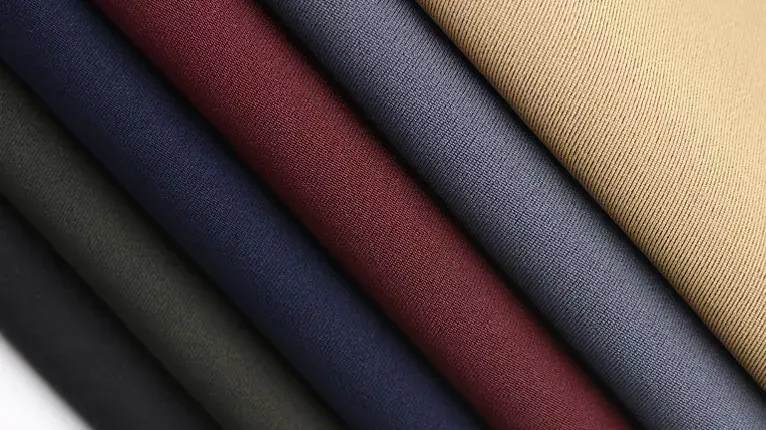
01
Abrasion fastness
Abrasion fastness refers to the ability to resist wear and friction, which helps improve the durability of the fabric. Clothing made from fibers with high breaking strength and good abrasion fastness can be worn for a long time and show signs of wear and tear after a long time.
Nylon is widely used in sports outerwear, such as ski jackets and football shirts. This is because its strength and abrasion resistance are particularly good. Acetate is often used as a lining for outerwear and jackets due to its excellent drape and low cost.
However, due to the poor abrasion resistance of acetate, the lining is prone to wear or holes before the outer fabric of the jacket shows corresponding wear.
02
Water absorbency
Hygroscopicity is the ability to absorb moisture, which is usually expressed by moisture regain. The water absorption of fibers refers to the percentage of moisture absorbed by dry fibers in the air under standard conditions of a temperature of 70°F (equivalent to 21°C) and a relative humidity of 65%.
Fibers that easily absorb water are called hydrophilic fibers. All natural animal and vegetable fibers and two man-made fibers, viscose and acetate, are hydrophilic fibers. Fibers that have difficulty absorbing water or can only absorb a small amount of water are called hydrophobic fibers. All man-made fibers except viscose, Lyocell and acetate are hydrophobic fibers. Fiberglass does not absorb water at all, and other fibers typically have a moisture regain of 4% or less.
The water absorption of fiber affects its application in many aspects, including:
Skin comfort:Due to poor water absorption, the flow of sweat can cause cold and wet skin Feel.
Electrostatic properties:With hydrophobic fibers, problems such as clothing sticking and sparking will occur, because there is almost no moisture to help disperse the charged particles accumulated on the fiber surface, and dust is also brought to the fibers due to static electricity and adheres to them.
Dimensional stability after washing:After washing, hydrophobic fibers shrink less than hydrophilic fibers, and the fibers rarely expand, which is one of the reasons for fabric shrinkage.
Contamination removal:Stains are easily removed from hydrophilic fibers because the fibers attract both detergent and water.
Water repellency:16
Thermoplastic
The heat resistance of fiber is an important factor affecting its application performance. This is also an important factor to consider in fiber processing in general, as fibers are exposed to heat during many fabric-forming processes, such as dyeing, ironing, and heat setting. In addition to this, heating is often used to care and renew clothing and interior furniture.
Some thermal effects are temporary and obvious only during the process. For example, in dyeing, the properties of fibers can change during the application of heat, but return to normal upon cooling. But some of the effects of heat can be permanent, as molecules rearrange after heat and cause the fiber itself to degrade. Heat setting, on the other hand, changes the molecular arrangement, making the fabric more stable (little shrinkage) and more resistant to wrinkles, but without significant degradation. However, prolonged exposure to high temperatures may cause degradation, such as loss of strength, fiber shrinkage, and discoloration. Many consumers have experienced excessively high ironing temperatures, which can cause severe fabric degradation or even damage clothing.
When heated, thermoplastic fibers become soft and can melt into a liquid state at higher temperatures. Many man-made fibers are thermoplastic. By applying heat to a fabric containing thermoplastic fibers to form creases and pleats without melting the fibers, long-lasting creases and pleats can be created when the temperature drops. Thermoplastic fibers can be molded when heated (softened) and the molded shape is retained when cooled (care must be taken when ironing garments made from man-made fibers to avoid softening or melting. When softened or melted, The fabric will begin to stick to the iron) and the creases will be permanent unless higher temperatures are used to remove the effects of the original heat setting. The shape of clothing can also be formed in this way, and thermoplastic fabrics have good dimensional stability.
17
wicking
Wicking is the ability of fibers to transfer moisture from one place to another. Normally, moisture is transferred along the surface of the fiber, but liquid can also pass through the fiber when it is absorbed by the fiber. The wicking tendency of fibers often depends on the chemical and physical composition of the outer surface. Smooth surfaces will reduce the effect of wicking.
Certain fibers, such as cotton fiber, are hydrophilic fibers and also have good wicking properties. Other fibers, such as olefins, are hydrophobic fibers but have good wicking properties when the denier is small (i.e. very fine fibers). This property is particularly important for garments such as training and running wear. The sweat discharged by the human body is transferred to the outer surface of the clothing along the fiber surface by wicking, and evaporates into the air, thus bringing better comfort.







